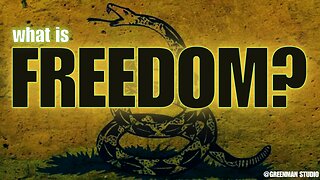Premium Only Content

Iran and Iraq - Part 4 Resistance Unites Against Occupation
UK US EU Armed Genocide in Gaza
Iran and Iraq - Part 4 Resistance Unites Against Occupation
Iraqi dictator Saddam Hussein, in his final days in power, clutched at straws and was even willing to give up the country’s natural resources to the US to reverse his fate. But the US eventually invaded Iraq under the pretext that Saddam possessed WMDs. As the next step, the US sought to cause sectarian rifts in the country to push its plans forward. However, it faced a bigger obstacle; the popular resistance forces.
Google AI Overview
The premise that Saddam Hussein offered to give the U.S. natural resources to avoid invasion is not supported by credible evidence. While US officials did claim that Hussein was developing Weapons of Mass Destruction (WMDs) as a primary justification for the invasion, this was later proven to be incorrect. The subsequent rise of sectarian conflict and armed resistance in Iraq is well-documented.
Here is a breakdown of the claims made in the user request:
Claim: Saddam offered natural resources to the U.S.
Fact: There is no credible public record or evidence that Saddam Hussein offered the U.S. a deal involving natural resources to halt the 2003 invasion.
Context: Discussions about Iraq's oil were largely absent from official statements by the Bush administration leading up to the war, with top officials like Colin Powell and Donald Rumsfeld remaining silent on the subject.
Claim: The U.S. invaded under the pretext of WMDs
Fact: This statement is largely accurate. The main justification given by the George W. Bush administration for the invasion was that Iraq possessed an active WMD program and posed a threat to U.S. security.
Context:
Intelligence used to justify the war, such as claims of Iraqi aluminum tubes for nuclear weapons and biological weapons labs, was later discredited.
Following the invasion, the Iraq Survey Group (ISG) searched for WMDs and concluded that Iraq had ended its major WMD programs in 1991 and had no stockpiles.
In 2004, the head of the ISG, David Kay, testified before Congress, stating, "We were all wrong" about Iraq possessing WMD stockpiles.
Claim: The U.S. sought to cause sectarian rifts
Fact: The U.S. did not explicitly plan to cause sectarian rifts. However, certain US policies implemented after the invasion unintentionally exacerbated them.
Context:
A significant policy blunder was the sweeping "de-Ba'athification" of the government and the disbanding of the Iraqi army. This alienated and politically marginalized many Sunnis and created a vacuum of power and security, which groups like al-Qaeda and other Sunni militias later exploited.
As sectarian violence erupted, U.S. forces found themselves caught between different factions.
One proposal, known as the Biden Plan, advocated for partitioning Iraq into three semi-autonomous regions, but this was a proposal for federalism, not full partition, and it never came to fruition.
Claim: The U.S. faced a bigger obstacle in popular resistance forces
Fact: This claim is true. The U.S. did face significant and widespread resistance following the initial invasion, not a unified, popular force but a variety of different groups.
Context:
The resistance to occupation led to a prolonged insurgency and civil war.
This resistance was not monolithic and included a mix of groups with varying motivations, such as former Ba'athist regime loyalists, nationalist figures, and extremist militants who flooded into the country.
One of the most prominent resistance figures was Muqtada al-Sadr, the son of a revered religious leader, who led the Mahdi Army militia.
Today, various Iran-backed militias operating under the umbrella of the Islamic Resistance in Iraq continue to conduct attacks against U.S. forces.
Join the Weekly Video Call
constitutionhelp.com
-
 LIVE
LIVE
LFA TV
9 hours agoLIVE & BREAKING NEWS! | WEDNESDAY 12/10/25
3,231 watching -
 LIVE
LIVE
Crypto Power Hour
12 hours ago $1.26 earnedShe’s ranked in the top 50 in BlockchainBlockchain, Alyze Sam
1,539 watching -
 17:30
17:30
Scammer Payback
17 hours agoUnbelievable Scammer Meltdown Mid-Scam
4.66K3 -
 11:10
11:10
ARFCOM News
17 hours ago $2.50 earnedBusted For Ordering Ammo + Rarebreed Slapped By Deez Nutz + 4/5 Guns Come From A Dealer?!?
5.41K5 -
 LIVE
LIVE
BEK TV
23 hours agoTrent Loos in the Morning - 12/10/2025
197 watching -
 2:55
2:55
GreenMan Studio
14 hours agoWHAT IS FREEDOM? w/ GreenMan Reports
4.09K -
 LIVE
LIVE
The Bubba Army
22 hours agoDONALD TRUMP SAYS "Black People Love Trump!" - Bubba the Love Sponge® Show | 12/10/25
1,315 watching -
 29:54
29:54
ZeeeMedia
14 hours agoAus Social Media Ban & British Govt's 'Emotion Detection' Cameras | Daily Pulse Ep 159
10.4K20 -
 LIVE
LIVE
GritsGG
17 hours agoBO7 Warzone Is Here! Win Streaking! New Leaderboard?
452 watching -
 1:00:41
1:00:41
Coin Stories with Natalie Brunell
18 hours agoBitcoin, Chasing Freedom & Breaking the Victimhood Cycle with Efrat Fenigson
68.7K2